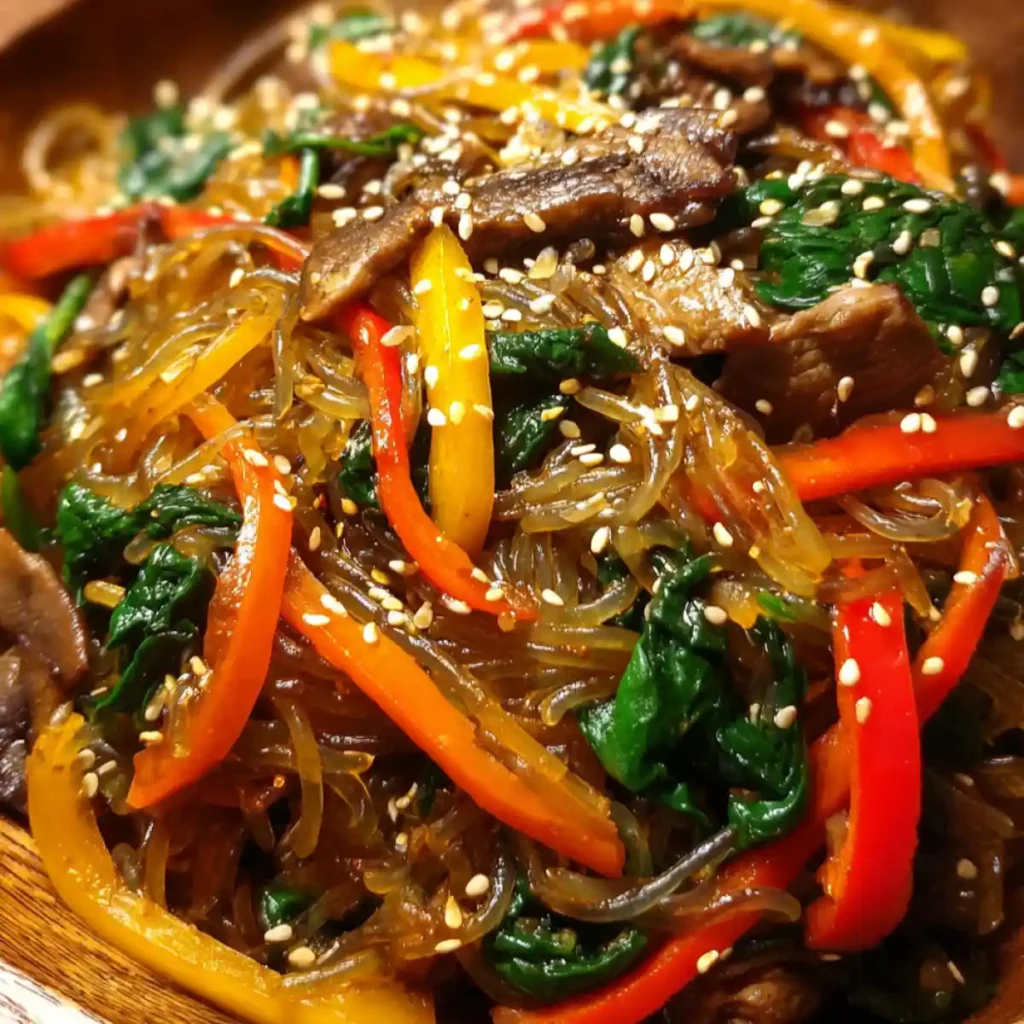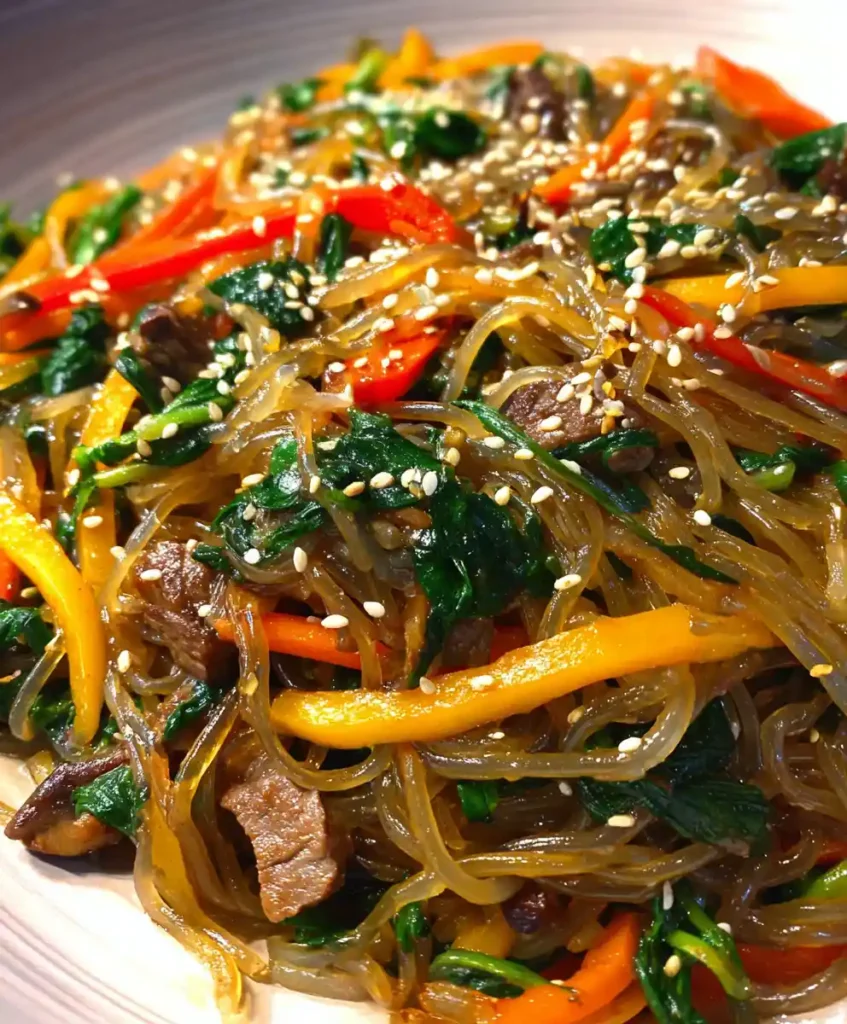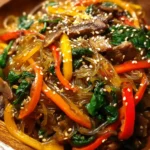On my busiest nights, I often crave a meal that’s both comforting and vibrant — stick with me and I’ll show you how to make exactly that!
Tired of the same old dinner routine? Craving something vibrant, flavorful, and satisfying, but still easy enough for a weeknight? This Japchae Recipe Korean Glass Noodle Stir Fry is your answer! We’re diving into the wonderful world of Korean Glass Noodle Stir Fry, a perfect dish for busy families, adventurous home cooks, and anyone looking for a wholesome, hearty meal. Get ready to transform simple ingredients into a delicious, colorful, and surprisingly quick meal that will become a family favorite, much like my own go-to Japchae Recipe.

Table of Contents
Table of Contents
Ingredient Spotlight and Why They Matter
Making a truly authentic Japchae Recipe relies on specific ingredients, each playing a vital role in its unique texture and flavor profile.
- Glass Noodles (Dangmyeon): The star! These chewy, translucent sweet potato starch noodles are fantastic because they soak up all the delicious sauce and flavors.
- Beef or Protein of Choice: Thinly sliced beef (sirloin or flank) adds richness, but for a healthy, high-protein meal, you can easily use chicken, shrimp, firm tofu, or even more mushrooms for a vegetarian Japchae.
- Vibrant Vegetables: Fresh spinach (or frozen, thawed and squeezed dry), crisp carrots, sweet onion, colorful bell peppers, and earthy shiitake mushrooms bring essential color, nutrition, and delightful texture to this veggie-packed meal.
- Flavorful Sauce: A balanced blend of soy sauce (or tamari), fragrant sesame oil, a touch of sugar, minced garlic, and black pepper creates the signature sweet and savory balance that defines this dish.
Substitutions and Alternatives
Part of what makes this Korean Glass Noodle Stir Fry such a great option for family dinners is its flexibility!
- Protein Swaps: Easily make it vegetarian or vegan with firm tofu, tempeh, or by simply increasing the mushroom quantity.
- Veggie Variations: Feel free to use zucchini, cabbage, snap peas, or any other crisp vegetables based on what you have on hand.
- Dietary Adjustments: For those managing sodium intake, use low-sodium soy sauce. For a soy-free option, coconut aminos work wonderfully. A sugar substitute can also be used for lower-carb versions, making this a truly adaptable recipe.
Notes on Pantry Staples & Freshness
- Noodles: Always use authentic Korean sweet potato starch noodles (dangmyeon) for the best, most satisfying chewy texture in your Japchae.
- Freshness: Fresh spinach and crisp, vibrant vegetables make a significant difference in both the taste and beautiful presentation of this easy dinner idea.
Easy Cooking Instructions for Japchae Recipe Korean Glass Noodle Stir Fry
Let’s get cooking! This straightforward method ensures a perfect Japchae every time, making it one of my favorite quick meals.
- Cook the Glass Noodles: Boil according to package directions until tender but still chewy (al dente). Rinse immediately with cold water to prevent sticking, then toss with a little sesame oil. This crucial step ensures lovely, separated noodles.
- Prep Your Ingredients: Slice all vegetables thinly and uniformly for even cooking. If using beef, marinate it for 10-15 minutes in a little soy sauce and garlic to infuse flavor.
- Sauté Each Component: Briefly cook vegetables and meat separately. This ensures perfect texture and bright colors without overcooking. Be sure not to overcrowd the pan — work in batches if necessary!
- Assemble and Stir-Fry: In a large wok or skillet, combine the cooked noodles, all the sautéed vegetables, meat (if using), and the prepared sauce. Stir gently until everything is evenly coated and heated through. This is where your Japchae comes together!
- Garnish and Serve: Finish with a sprinkle of toasted sesame seeds and an optional drizzle of extra sesame oil for an extra layer of nutty flavor.
Inline Variation Notes
Whether you want a heartier or lighter version of this Korean Glass Noodle Stir Fry, it’s easy to adjust.
- Heartier Version: Increase the amount of protein, or add an extra egg omelet, thinly sliced, to make it even more substantial.
- Lighter Version: For a healthy, lower-carb meal prep option, reduce the amount of noodles and increase the vegetables significantly.
- Kid-Friendly: Finely dice vegetables to make them less noticeable, and consider using a less pungent mushroom variety like cremini instead of shiitake.
Quick Warnings for Success
- Don’t Overcook Noodles: They can quickly become mushy. Aim for a firm, springy texture, then rinse immediately.
- Overcrowding the Pan: This is a common mistake! Cook in batches if necessary to ensure even cooking and to achieve a stir-fry rather than steaming your ingredients.
Everyday Uses and Make-Ahead Convenience
This delightful Japchae Recipe Korean Glass Noodle Stir Fry is incredibly versatile, making it a star in any home kitchen. Whether you’re planning ahead or need a quick meal, it fits right into your busy schedule.
- Family Meals: A perfect weeknight dinner, satisfying and packed with veggies, making healthy eating simple and enjoyable for everyone.
- Gatherings: Impress guests with this vibrant dish for potlucks or special occasions. It’s a beautiful, family-friendly dish that always gets rave reviews.
- Lunch Boxes: Excellent cold or reheated, making it a fantastic meal prep option for nutritious and delicious lunches.
- Quick Weeknight Dinners: Can be prepped in stages to speed up assembly on busy evenings, a true lifesaver for quick dinner ideas.
Creative Serving Ideas
While delicious on its own, here are a few ways to enjoy your Korean Glass Noodle Stir Fry:
- Main Dish: Serve as is, perhaps with a side of steamed rice or a fresh, crisp kimchi.
- Side Dish: A delicious accompaniment to grilled meats or other Korean main courses, adding color and texture to your spread.
- Toppings: Garnish with a fried egg, more toasted sesame seeds, or a sprinkle of chili flakes for a gentle kick.
- Pairings: Enjoy with a light soup or a refreshing green salad for a complete meal.
Make-Ahead Tips for Japchae Korean Glass Noodle Stir Fry
One of my favorite things about this dish is how well it holds up, making it ideal for healthy meal prep.
- Batch Cooking: Cook a larger portion to last for several meals throughout the week, saving you time and effort later.
- Storage: Store cooled Japchae in an airtight container in the refrigerator for up to 3-4 days.
- Reheating: Gently reheat in a microwave or a skillet with a splash of water or broth to loosen the noodles and restore their texture.
- Freezing: While possible, noodles may become softer after freezing and thawing. For the best experience, it’s best enjoyed fresh or simply refrigerated.
Nutrition & Lifestyle Advantages of Japchae Korean Glass Noodle Stir Fry
Beyond its incredible flavor, this Japchae Recipe offers significant benefits for a healthy, active lifestyle.
- Balanced Meal: Offers a good mix of carbohydrates (noodles), lean protein (meat/tofu), and plenty of essential vitamins from fresh vegetables, making it a wholesome choice.
- Energy and Wellness: Provides sustained energy without feeling heavy, making it a great option for an active lifestyle that demands nourishing, veggie-packed meals.
- Weight Support: Easily customizable to be lighter by increasing vegetables and reducing noodles, supporting your healthy eating goals.
Common Dietary Patterns
This versatile Korean Glass Noodle Stir Fry can be adapted to suit various dietary needs.
- Gluten-Free: Easily made gluten-free using 100% sweet potato starch noodles and tamari (a gluten-free soy sauce alternative).
- Vegan/Vegetarian-Friendly: Simple protein swaps with firm tofu, tempeh, or additional mushrooms make this an ideal plant-based meal, perfectly fitting into a vegetarian lifestyle.
- Diabetic-Friendly: Can be adapted with controlled portion sizes and natural sugar substitutes, under guidance from a health professional.

Why This Recipe Helps You Save Time and Money
Who doesn’t love a recipe that is as kind to your wallet as it is to your schedule? This Japchae Recipe does just that, proving that a delicious, hearty meal doesn’t have to be expensive or time-consuming.
- Simplifies Cooking: Uses common pantry ingredients and a straightforward stir-fry method, cutting down on complexity.
- Budget-Friendly: Noodles and vegetables are economical, effectively stretching more expensive proteins and helping you create affordable family dinners.
- Easy Prep: Minimal fussy techniques, mostly chopping and quick cooking, means less time in the kitchen.
- Family Appeal: A crowd-pleaser that even picky eaters often enjoy due to its mild, savory flavor and fun noodle texture.
- Leftovers Love: Tastes great the next day, making it perfect for packed lunches or a healthy grab-and-go meal.
Smart Tips, Adjustments, and Special Notes
Elevate your Korean Glass Noodle Stir Fry with these simple enhancements and ensure it meets your family’s specific needs.
- Upgrades for Flavor and Presentation: Add a touch of gochugaru (Korean chili flakes) for mild heat. Garnish with slivers of toasted seaweed or fresh cilantro for an extra layer of visual appeal and taste.
- Adjustments for Taste:
- Adjust sweetness by adding more or less sugar to your preference.
- Increase umami with a dash of mushroom powder or extra soy sauce for deeper flavor.
- For a richer flavor, use beef stock instead of water when rehydrating dried mushrooms.
- Safety and Allergy-Friendly Tweaks for Families:
- Ensure all ingredients are certified gluten-free if needed for family members with sensitivities.
- For nut allergies, ensure sesame oil is the only oil used and avoid cross-contamination in your kitchen.
- Always check individual family member preferences for spiciness before adding chili flakes.
Common Questions About Japchae Recipe Korean Glass Noodle Stir Fry
Is Japchae good for a low-carb diet?
While traditional Japchae is not low-carb due to the sweet potato glass noodles, you can significantly reduce the carbs by increasing vegetables and using fewer noodles. Consider a ‘noodle-light’ version for a healthier choice.
Can I freeze Japchae for meal prep?
You can freeze Japchae, but the noodles may change texture slightly after thawing, becoming a bit softer. For optimal texture and flavor, it’s best eaten fresh or refrigerated for up to 3-4 days as a healthy meal prep option.
What are the best healthy sides to serve with Japchae?
Kimchi, steamed edamame, a light cucumber salad, or simple steamed greens are wonderful healthy sides that complement the flavors of the Korean Glass Noodle Stir Fry beautifully.
How do I prevent my Japchae noodles from sticking?
After cooking, rinse the noodles with cold water to stop the cooking process and remove excess starch. Then, toss them immediately with a little sesame oil. This crucial step prevents them from sticking together.
What kind of noodles are used in Japchae?
Authentic Japchae uses glass noodles made from sweet potato starch, known as dangmyeon, which gives them their signature chewy, translucent texture. These noodles are naturally gluten-free.
Can I make Japchae vegetarian or vegan?
Absolutely! Simply omit the meat and use firm tofu, tempeh, or additional mushrooms as your protein source. For a vegan version, ensure your sauce is also free of any non-vegan ingredients like honey (though not common in this dish).
How long does Japchae last in the fridge?
Cooked Japchae will stay fresh and delicious in an airtight container in the refrigerator for 3 to 4 days. It makes for excellent leftovers!
This Japchae Recipe for Korean Glass Noodle Stir Fry isn’t just a meal; it’s a passport to delicious, easy, and satisfying home cooking. It’s proof that you can create vibrant, hearty, and family-friendly dishes without spending hours in the kitchen. Add this incredible recipe to your weekly rotation, share it with loved ones, or simply enjoy the delicious journey of bringing a taste of Korea to your dinner table tonight!
Don’t forget to save this amazing Japchae Recipe on Pinterest for quick dinner ideas and healthy meal prep inspiration!
Print
Japchae Recipe Korean Glass Noodle Stir Fry
- Total Time: 50 minutes
- Yield: 4 servings
- Diet: Vegetarian
Description
Vibrant and flavorful Korean Glass Noodle Stir Fry (Japchae) is a satisfying, easy weeknight meal. Features chewy sweet potato noodles, beef/tofu, and fresh veggies.
Ingredients
- Glass Noodles (Dangmyeon)
- Beef or Protein of Choice: Thinly sliced beef (sirloin or flank)
- Vibrant Vegetables: Fresh spinach (or frozen, thawed and squeezed dry), crisp carrots, sweet onion, colorful bell peppers, and earthy shiitake mushrooms
- Flavorful Sauce: A balanced blend of soy sauce (or tamari), fragrant sesame oil, a touch of sugar, minced garlic, and black pepper
Instructions
- Cook the Glass Noodles: Boil according to package directions until tender but still chewy (al dente). Rinse immediately with cold water to prevent sticking, then toss with a little sesame oil. This crucial step ensures lovely, separated noodles.
- Prep Your Ingredients: Slice all vegetables thinly and uniformly for even cooking. If using beef, marinate it for 10-15 minutes in a little soy sauce and garlic to infuse flavor.
- Sauté Each Component: Briefly cook vegetables and meat separately. This ensures perfect texture and bright colors without overcooking. Be sure not to overcrowd the pan — work in batches if necessary!
- Assemble and Stir-Fry: In a large wok or skillet, combine the cooked noodles, all the sautéed vegetables, meat (if using), and the prepared sauce. Stir gently until everything is evenly coated and heated through. This is where your Japchae comes together!
- Garnish and Serve: Finish with a sprinkle of toasted sesame seeds and an optional drizzle of extra sesame oil for an extra layer of nutty flavor.
Notes
Substitutions & Variations: Easily make it vegetarian or vegan with firm tofu, tempeh, or by increasing mushrooms. Use zucchini, cabbage, or snap peas for veggie variations. For dietary adjustments, use low-sodium soy sauce, coconut aminos for soy-free, or a sugar substitute for lower-carb. For a heartier dish, add more protein or sliced egg omelet. For a lighter version, reduce noodles and increase vegetables. For kid-friendly, finely dice vegetables and use cremini mushrooms.
Pantry & Freshness: Always use authentic Korean sweet potato starch noodles (dangmyeon) for the best texture. Fresh spinach and crisp vegetables make a significant difference in taste and presentation.
Quick Warnings: Do not overcook noodles; aim for firm, springy texture and rinse immediately. Avoid overcrowding the pan; cook in batches to ensure proper stir-frying rather than steaming.
Nutrition information is an estimate based on common ingredients and preparation.
- Prep Time: 25 minutes
- Cook Time: 25 minutes
- Category: Dinner
- Method: Stovetop
- Cuisine: Korean
Nutrition
- Serving Size: 1 serving
- Calories: 450
- Sugar: 8g
- Sodium: 650mg
- Fat: 18g
- Saturated Fat: 3g
- Unsaturated Fat: 12g
- Trans Fat: 0g
- Carbohydrates: 60g
- Fiber: 6g
- Protein: 25g
- Cholesterol: 30mg
Keywords: Japchae
